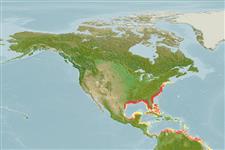Actinopterygii (ray-finned fishes) >
Perciformes (Perch-likes) >
Sciaenidae (Drums or croakers)
Etymology: Sciaenops: Greek, skiaina, skion = a fish, red mullet + Greek, ops = appearance (Ref. 45335).
Environment / Climate / Range
Ecology
Marine; brackish; demersal; oceanodromous (Ref. 51243); depth range 10 - ? m (Ref. 9988). Subtropical, preferred 25°C (Ref. 107945); 43°N - 0°S
Western Atlantic: Massachusetts in USA to northern Mexico, including southern Florida, USA.
Length at first maturity / Size / Weight / Age
Maturity: Lm 86.3, range 55 - 80.3 cm
Max length : 155 cm TL male/unsexed; (Ref. 3702); common length : 100.0 cm TL male/unsexed; (Ref. 3702); max. published weight: 45.0 kg (Ref. 9988); max. reported age: 50 years (Ref. 32563)
Occurs usually over sand and sandy mud bottoms in coastal waters and estuaries. Abundant in surf zone. Feeds mainly on crustaceans, mollusks and fishes. Utilized fresh and frozen; can be pan-fried, broiled and baked (Ref. 9988).
Robins, C.R. and G.C. Ray, 1986. A field guide to Atlantic coast fishes of North America. Houghton Mifflin Company, Boston, U.S.A. 354 p. (Ref. 7251)
IUCN Red List Status (Ref. 115185)
CITES (Ref. 94142)
Not Evaluated
Human uses
Fisheries: minor commercial; aquaculture: commercial; gamefish: yes; aquarium: public aquariums
Tools
Special reports
Download XML
Internet sources
Estimates of some properties based on models
Phylogenetic diversity index (Ref.
82805): PD
50 = 1.0000 [Uniqueness, from 0.5 = low to 2.0 = high].
Bayesian length-weight: a=0.00832 (0.00520 - 0.01330), b=3.07 (2.94 - 3.20), in cm Total Length, based on LWR estimates for this species & (Sub)family-body (Ref.
93245).
Trophic Level (Ref.
69278): 3.7 ±0.57 se; Based on food items.
Resilience (Ref.
69278): Medium, minimum population doubling time 1.4 - 4.4 years (K=0.27; tmax=7; Fec~1 million).
Prior r = 0.57, 2 SD range = 0.22 - 1.45, log(r) = -0.56, SD log(r) = 0.47, Based on: 1 M, 14 K, 9 tgen, 3 tmax, 1 Fec records
Vulnerability (Ref.
59153): Moderate vulnerability (43 of 100) .
